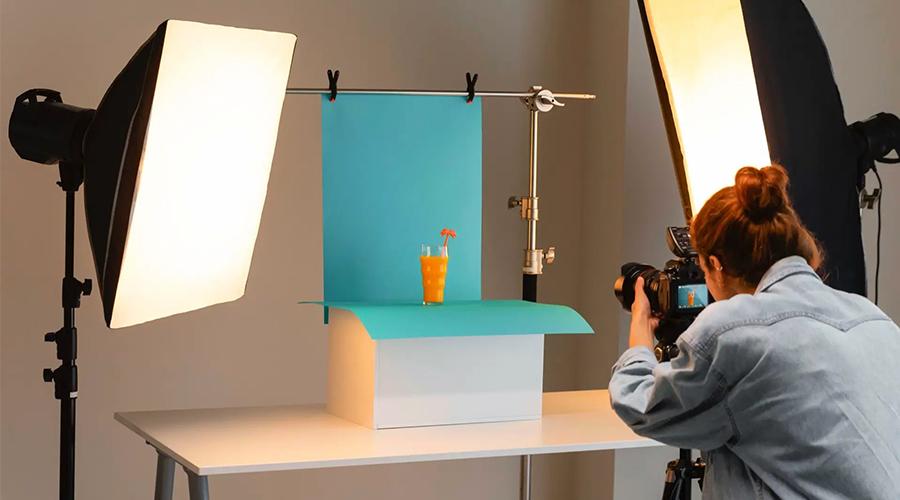Best Selling Products
6 Tips for Taking Professional Product Photos
Nội dung
- 1. Pay attention to the message in each photo
- 1.1. Choose the right context
- 1.2. Create a connection between the product and the user
- 1.3. Focus on details
- 2. Natural light vs artificial light
- 2.1. Natural light: The ideal choice
- 2.2. Artificial Light: Better Control
- 2.3. Combination of natural and artificial light
- 3. Shoot, edit, print, edit, print
- 3.1. Step 1: Take a photo of the product with perfect lighting
- 3.2. Step 2: Adjust the camera and create various shooting angles
- 3.3. Step 3: Edit the photo carefully
- 3.4. Step 4: Print photos in high quality
- 3.5. Step 5: Edit if necessary
- 4. Use photo editing software
- 4.1. Adjust light and color
- 4.2. Add effects and color filters
- 4.3. Enhance sharpness and brightness
- 5. Update trends, don't follow trends
- 5.1. Why should you update trends?
- 5.2. Understand customers to choose the right trend
- 6. Choose the right equipment
- 6.1. DSLR or mirrorless camera
- 6.2. Smartphone with high quality camera
- 7. Conclusion
Want to have beautiful and professional product photos? Check out 6 product photography tips from SA Design to create impressive photos that attract customers.

In today's online sales world, having high-quality product photos is an important factor in attracting customers. Product photography is not just about creating a simple photo, but how you convey the message and value of the product to the viewer. To help you get professional photos, in the following article, Sadesign will share 6 tips that cannot be ignored when taking product photos, helping you create beautiful and impressive photos.
1. Pay attention to the message in each photo
Product photography is not just about “pressing the button” to take a photo, but more importantly, it is about what message you convey through each photo. Each product has its own value, story and message that you need to skillfully express through each photo.
.jpg)
1.1. Choose the right context
The first thing you need to consider when taking product photos is the setting. A suitable space or background can not only help highlight the product, but also evoke emotions and reflect the right product. For example, if you are selling fashion products, you can choose a setting that matches the fashion style of the product. For technology products, a modern and minimalist space will help your product stand out.
1.2. Create a connection between the product and the user
Each photo should connect the product to the potential user. This makes it easy for customers to imagine how the product will be used in everyday life. You can take photos of the product in a real-life usage environment, such as a phone being used in the office, or a shirt being worn at a party.
1.3. Focus on details
Sometimes, the little details make a big difference. Pay attention to every angle and detail on your product, such as the material, pattern, stitching, or special features. These elements will create an attractive photo and convince customers that your product is the best choice.
2. Natural light vs artificial light
Lighting is an important element in professional product photography. Choosing the right lighting will help highlight product features and create beautiful photos.
2.1. Natural light: The ideal choice
Natural light is often preferred for product photography because it provides soft and realistic light. If you can take advantage of natural light from windows or outdoor spaces, it will be a big advantage. Natural light helps the product colors become more realistic, not distorted as much as when using artificial light.
.jpg)
However, natural light also has certain disadvantages, such as constant changes in intensity and direction. This can be difficult if you want to get photos that are evenly and consistently lit.
2.2. Artificial Light: Better Control
Artificial lighting, especially flash and professional studio lighting, allows you to control the brightness and direction of the light more precisely. This will help you achieve evenly lit photos and easily create special lighting effects. However, when using artificial lighting, you need to pay attention to using light diffusers or filters to avoid creating unwanted shadows or harsh lighting.
2.3. Combination of natural and artificial light
To take advantage of both types of light, you can combine natural light and artificial light. Natural light will be the main light source, while artificial light will help create highlights and highlight details on the product. This combination will bring the best photography effect, making your product look more prominent and attractive.
3. Shoot, edit, print, edit, print
Product photography is more than just pressing a button and waiting for the results. Getting the perfect shot requires a thoughtful and meticulous process of “shoot, edit, print.” Here are the important steps in this process.
.jpg)
3.1. Step 1: Take a photo of the product with perfect lighting
Lighting is extremely important in product photography. A good photo cannot exist without proper lighting. Avoid using direct flash, as it can create unwanted shadows or reduce the quality of the image.
Instead, use natural light or soft light sources that highlight the features of your product without taking away from its natural look. You should also experiment with different light sources such as front lighting, overhead lighting, or reflectors to find the lighting that works best for you.
3.2. Step 2: Adjust the camera and create various shooting angles
When it comes to product photography, choosing the right angle is key. Products can look very different depending on the angle and how you position your camera. Some products look better when shot from above, while others look better when shot from a horizontal angle.
Experiment with different angles to highlight the product's features. Also, don't forget to adjust camera settings like aperture, shutter speed, and ISO to ensure the sharpest image quality.
3.3. Step 3: Edit the photo carefully
After taking a photo, editing is an important part that cannot be ignored. Editing helps you remove defects such as uneven lighting, product stains, or factors that affect the aesthetics of the photo.
Use photo editing tools like Photoshop or Lightroom to adjust the brightness, contrast, color, and sharpness of your images. However, be careful not to over-edit, as this can make the image look unnatural.
3.4. Step 4: Print photos in high quality
Once you've finished editing, you can print your photos for use in advertising campaigns, catalogs, or product packaging. To ensure quality prints, use a professional printer and quality paper that will help maintain the sharpness of the image.
Make sure that the images are printed in high resolution, with minimal pixelation and natural colors. This will help you create photos that are not only beautiful but also sharp, clear, and easily attract the attention of customers.
3.5. Step 5: Edit if necessary
Even after printing, you may find that some details need to be retouched. This is okay, as every creative process involves changes and adjustments. Don’t hesitate to retouch your photos after printing if necessary to ensure the image is perfect.
4. Use photo editing software
Photo editing has become an indispensable tool in the product photography process. Whether you use a camera or a smartphone to take photos, an unedited photo will not fully show the product's highlights. Photo editing software helps you adjust the brightness, contrast, sharpness, and even the color of the product to make it most attractive and realistic.
Popular photo editing software such as Adobe Photoshop, Lightroom, or mobile apps like Snapseed, VSCO can all help you improve your product photos. Using these tools not only makes your products stand out, but also helps create consistency for all the products in your collection, which is important in building a professional brand image.
4.1. Adjust light and color
One of the most common photo editing tasks is adjusting the lighting and color. This helps to make the product more vibrant and true to life, and creates a sharp contrast between the product and the background. Tools like Adobe Lightroom or Photoshop can help you make these adjustments easily.
4.2. Add effects and color filters
To make your photos stand out and stand out, you can add effects or filters. These effects can create a unique atmosphere and help your products stand out to customers. However, make sure that these effects do not take away from the authenticity of the product.
4.3. Enhance sharpness and brightness
One of the most basic and important editing techniques is to enhance the sharpness and brightness of the photo. Blurry or underexposed photos will make the product difficult to see and will not attract the attention of customers. Adjusting the brightness and contrast properly will help the product stand out more, while bringing a more realistic and attractive feeling to the viewer.
5. Update trends, don't follow trends
In the photography industry, especially when it comes to product photography, keeping up with trends is essential. However, to truly succeed in creating impressive product photos, you need to understand one principle: "Keep up with trends, don't follow trends."
.jpg)
5.1. Why should you update trends?
Trends in product photography can change rapidly from season to season, from year to year. One lighting style or shooting method may be popular for a short time, only to be replaced by a new trend. However, chasing only temporary trends can cause you to miss out on lasting value in photography.
Remember, no matter how trends change, the basics like natural lighting, product clarity, and space planning should always be a priority. Applying these enduring trends in product photography will help you create images that will last and avoid looking dated over time.
5.2. Understand customers to choose the right trend
Instead of just following trends, it is important to understand your target audience. Each product has a distinct audience, so choosing a photography style that suits them will bring the best results. For example, for high-end products, you can prioritize sophistication and gentleness in lighting and color arrangements. For products aimed at young people, dynamic photos with bright colors can be the right choice.
Remember that finding the right style will help you avoid getting caught up in the trend race while still maintaining uniqueness and professionalism in each photo.
6. Choose the right equipment
Choosing the right equipment is essential to taking professional product photos. While many people think that only professional cameras can take great photos, the reality is that a modern smartphone with a high-quality camera can produce equally good results.
6.1. DSLR or mirrorless camera
DSLR or mirrorless cameras are the best choice if you want sharp and detailed photos. These cameras allow you to adjust parameters such as aperture, shutter speed, and ISO, which helps you control the light and sharpness of the product. In addition, the lens is also an important factor that affects the quality of the image. A wide-angle lens can help you capture the whole product, while a macro lens will help you capture the most delicate details.
6.2. Smartphone with high quality camera
If you don’t have a professional camera at hand, don’t worry! Today’s smartphones are equipped with advanced camera technology, allowing you to take excellent product photos. Photo editing applications available on phones are also very convenient, helping you quickly edit and perfect your photos.
7. Conclusion
Professional product photography is a process that requires skill and meticulousness. However, with the above tips, you will easily create quality photos that not only help your products stand out but also attract customers. Apply these tips to your work and don't forget to visit Sadesign's website for advice on building your brand through impressive images.












































